
KUCHING, Aug 15: The Department of Irrigation and Drainage (DID) had carried out major studies before implementing the solutions in 2008 to tackle the flooding issue in Sibu which involved building bunds, pump stations and reservoirs.
Highlighting this, SUPP Bawang Assan chairman Senator Robert Lau emphasised that in fact, a group of experts from China were also engaged to review the plans by DID after being challenged by the late Wong Ho Leng, then the Sibu MP, in 2011.
“It was no surprise the Chinese experts endorsed the DID plan,” he said in a statement today.
He also noted the deliberation to his reference on Holland as an example on how to handle flood in Sibu was not a suitable comparison because Holland’s fight was with the sea that surrounded it and not like Sibu, which was not surrounded by sea.
“There is some element of truth in that statement although I will think that if the sea can be held at bay by the bunds or dykes, pump stations and reservoirs, more so it will work for low lying areas subject to flood from a big river, like Sibu,” he added.
Giving another example to support the solution to the flooding problem in Sibu, Lau pointed towards Wuhan and the neighbouring city of Huangshi in Hubei Province, China.
“The city is situated along China’s longest river, the Yangtze. It is about 400 km inland. Sibu is very similar to Wuhan in this respect as Sibu is situated about 110 km inland of Rajang.
“Geologically and geographically, Sibu is worse off as compared to Wuhan because Sibu is situated on peaty and low lying ground. With peat, the ground level sinks when the organic waste that made up the bulk of the peat decomposed or when the area is drained.
“Wuhan terrain is also flat but at least she sits on solid ground. Huangshi is surrounded by two big lakes but has a nice hill in the centre of the city,” he explained.
However, Lau added both Wuhan and Huangshi had faced severe flooding problems with many lives lost which was one of the reasons for building the ‘Three Gorges Dam’ to act as a reservoir of excess rainwater upriver.
“This is the similar role played by Bakun Dam here.
“I visited Wuhan and Huangshi slightly less than two years ago with the main aim of seeing the way the two cities deal with the flooding problem. The floods were caused by water overflowing the Yangtze.
“The two cities have built multiple layers of bunds along the river bank to prevent water from overflowing the inland. The two cities also have several pump stations and continue to upgrade and build new ones. I attached below links to some articles of the pump stations in Wuhan City. One article said Wuhan has 55 pump stations,” he said.
https://hb.sina.cn/news/2020-
http://news.cjn.cn/sywh/
Lau stressed that Phase 4 of the Sibu flood mitigation project was essential for Sibu urban renewal and the redevelopment of the slum of Bukit Assek-Tiong Hua Road as it will tackle the flooding problem in the slum area like what Phase 1 and 2 did for the area covered.
For about two weeks in July this year, he revealed that the water level of Rajang did not drop by much even during low tide, but it was not due to siltation of the river causing the tide level to be high for that period as alleged.
“It was because Bakun Dam was releasing water and it coincided with heavy rainfall for that period. The data from the DID Office bears this outcome.
“Now that Bakun is not releasing water and the weather is dry, the water level has gone back to normal. Water from the upper river reaches of Rajang continues to flow past Sibu without causing flooding even though the issue of siltation is still there,” he said.
He however agreed that dredging did play a role in certain parts of Sibu where the water was stagnated due to drain blockage or river mouth being silted in which the Rajang Port Authority used to carry out regular dredging work at the mouth of Seduan River at Sg Merah.
“There was a jetty for petrol vessels. Situated next to that jetty was an oil depot which vessels berthed and petroleum was delivered. This jetty has been abandoned more than 10 years ago after the depot moved to Tg Manis.
“Since the closure of that oil depot at Sg Merah, no dredging work at the river mouth has been done. Yet the water along Seduan River still finds its way out to Batang Igan without being the cause of flooding for the low-lying areas along the banks of the River,” he pointed out.
Lau thus said that the Phase 4 project, which was funded by the state government, should be welcomed as it was for the good of the people of Sibu, although the federal government should be the one funding it.
“There is nothing personal in my speaking on flooding in Sibu as it is an issue of concern for everyone who lives in Sibu like me.
“Discussing issues that concern the public is to be encouraged so long as we use facts and reasons to convince.
“Regardless, there is still the Phase 5 involving three pump stations and 3.5 km of bunds. I will make an effort to push for this project to take off under the federal budget. In addition, similar projects should also be implemented for the west bank of Sibu stretching from Igan Bridge to Lebaan Bridge. This will alleviate flooding problems there,” he said.-DayakDaily








